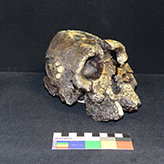Kenyanthropus platyops
Kenyanthropus platyops
Collections
Museum of Anthropology
at Rowan University
Click any image to enlarge
at Rowan University
Click any image to enlarge
Common Name: Flat-Faced Man
Scientific Name: Kenyanthropus platyops
Site collected from: West Lake Turkana, Kenya
Geographic Range: Western Lake, Turkana
Time Frame: 3.5 million years ago
Maximum Cranial Length: 6.29 inches
Height of Skull: 4.33 inches
There is not a great deal of information on Kenyanthropus platyops, which leaves many scientists to speculate about its lifestyle. Most scientists have concluded that Kenyanthropus platyops most likely “used simple tools that included sticks and other non-durable plant materials found in the immediate surroundings” (Australianmuseum.net). According to Australianmuseum.net, K. platyop’s mannerisms closely resembled those of fellow hominin Australopithecus afarensis.
Although K. platyop’s everyday behavior was similar to that of A. afarensis, its physical features were much different. Unlike A. afarensis, K. platyops had smaller ear holes, a flat face, and smaller molars (PBS). This leads most experts to believe that it’s more closely related to Homo rudolfensis or Homo habilis. One theory that evolutionary biologists employ, in order to explain how these three species are related, is convergent evolution (PBS). Convergent evolution simply means that these species, K. platyops, H. rudolfensis, and H. habilis, each adapted to similar environments in similar ways. Another explanation could be that they all share a distant common ancestor. Again, much more evidence is required in order to establish any further conclusions about Kenyanthropus platyops.




